Vibrant and tart with the flavor of pineapple, and infused with sweet cinnamon and star anise, tepache is a traditional fermented drink from Mexico. To make it, you'll need a pineapple, unrefined sugar like piloncillo or jaggery, spices, and a jar. After making this tepache recipe, let it culture at room temperature, and you'll have a vibrant sweet-tart, slightly effervescent drink in a few days.
Jump to Recipe | What is it? | Benefits | Making Tepache
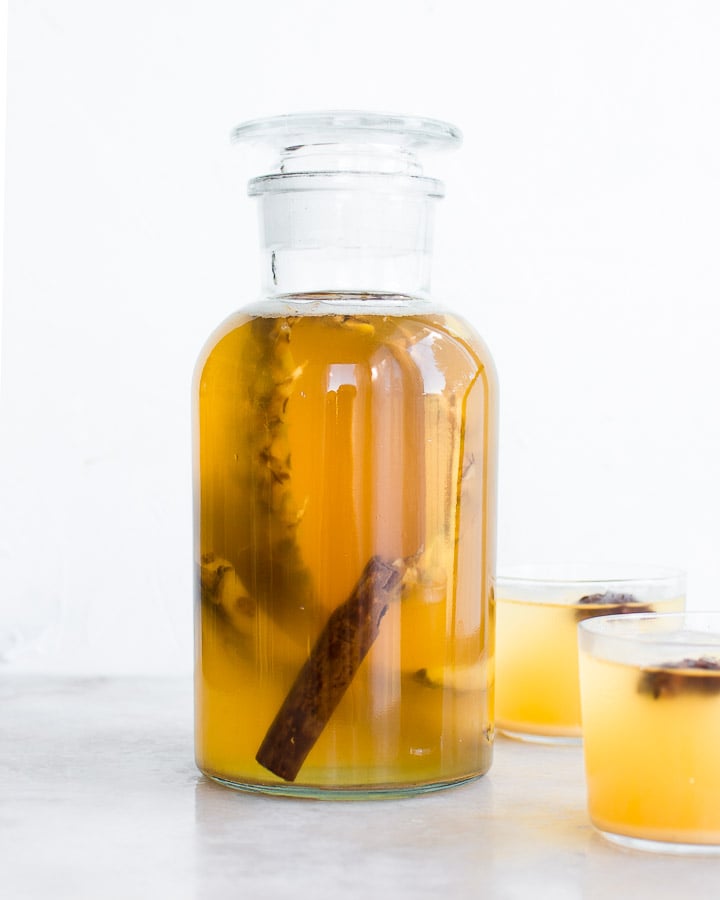
What is tepache?
Tepache is a fermented soft drink native to pre-hispanic Mexico (1). In addition, brewers traditionally made it with corn. But now, contemporary brewers typically use pineapple, cane sugar, and spices.
Tepache's flavor is vibrantly sweet and tart. Further, cinnamon and star anise infuse some tepache recipes with a distinct, sweet-spicy aroma.
Unrefined cane sugar also gives the drink a distinct floral note with mineral undertones. Occasionally, brewers will add water kefir (also known as tibicos) to the brew to kickstart fermentation. Using a starter helps it to brew faster.
These ingredients ferment at room temperature for 1 to 3 days. Hot, tropical temperatures allow the drink to ferment faster, while colder temperatures slow the fermentation process.
Tepache is usually served only lightly fermented as a soft drink, and even young children drink and enjoy it. However, some brewers ferment the drink for a longer period to produce an alcoholic version. And when you let it ferment for a month or longer, it will turn into pineapple vinegar. When you ferment the drink for a short period of time, it will have a very low alcohol content - similar to kombucha.
Is it good for you?
Like most fermented drinks and foods, tepache is rich in beneficial bacteria and probiotics as well as beneficial acids. Pineapple is a good source of enzymes and is rich in vitamin C.
Gut Health and Tepache
As a wild-fermented drink, specific cultures will vary from batch to batch and brewer to brewer. Most tepache recipes will contain lactic acid-producing bacteria including lactobacillus lactis, which is also found in buttermilk and cheese (2).
Most tepache brews will also contain beneficial yeasts like saccharomyces boulardii(3) which is associated with increased enzymatic activity and better nutrient delivery in the gut (4). It also plays a role in supporting gut health and the restoration of the gut barrier, so shows promise in addressing conditions related to leaky gut (5).
Vitamins, Minerals, and Enzymes
Pineapple contains a good amount of vitamin C, thiamin, and manganese. It's also rich in various food enzymes, like bromelain, which may help to support digestion.
During fermentation, beneficial bacteria and wild yeast consume sugars and produce beneficial acids and B vitamins. But even though tepache is fermented, it still tastes sweet. And that means there's still plenty of sugar remaining in your brew. So drink small amounts, and people prone to blood sugar imbalance may wish to skip this drink in favor of fermented vegetables.
Sourcing Your Pineapple
Since you'll use the pineapple rind to make tepache, you want to be particularly careful about how it's sourced. Pineapples are a pesticide-intensive crop, which means that the rind may contain significant residue.
Further, the use of pesticides and herbicides in conventional pineapple production is so intensive, it often sterilizes the soil, eliminates biodiversity. Even worse, conventional pineapple production has profound impact on the health of farm workers and community members (6).
For these reasons, take extra care to purchase organic or sustainably grown pineapple for this recipe.
How to Make Tepache
Most tepache recipes need only pineapple and unrefined sugar. But you can also add spices. And water kefir will give your brew a boost so it cultures faster.
Slice your pineapple peel, and reserve the fruit for another purpose.
Then warm a bit of unrefined sugar with water. Artisan producers make unrefined cane sugars like piloncillo and jaggery the traditional way, by boiling sugar cane juice into a fine syrup. Then they beat it as it crystallizes. The result is that it has a rich flavor and plenty of residual minerals.
Pour the sugar water over the pineapple peel. Drop in the spices. And then cover it with more water. Next, allow it to ferment for a few days, until lightly sweet, pleasantly tart, and faintly effervescent.
How to Serve Tepache
Tepache is delicious served over ice on a hot afternoon. You can dilute it with sparkling mineral water if you like, and it's also delicious with a shot of rum added to the glass for a light cocktail.
It pairs nicely with chips and fermented salsa for a light afternoon appetizer or served alongside lime soup at mealtime.
Where to find organic herbs and spices
You can find many fresh herbs at your local grocery store; however, medicinal herbs can be harder to find locally. We recommend Mountain Rose Herbs because they stock many organic and ethically wildcrafted culinary and medicinal herbs.
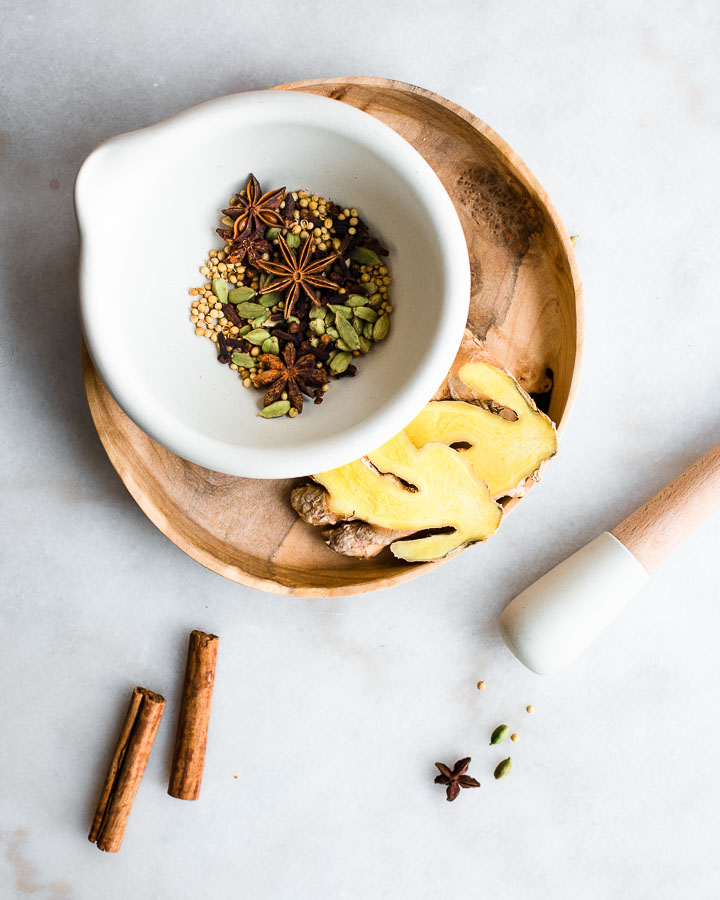
Other fermented drinks you might like
References
- Fuente‐Salcido, N. M., et al (2015), Isolation and characterization of bacteriocinogenic lactic bacteria from M‐Tuba and Tepache, two traditional fermented beverages in México. Food Sci Nutr, 3: 434-442.
- Fuente‐Salcido, N. M., et al (2015), Isolation and characterization of bacteriocinogenic lactic bacteria from M‐Tuba and Tepache, two traditional fermented beverages in México. Food Sci Nutr, 3: 434-442.
- Romera-Luna, H.W., et al (2018) Evaluation of the Probiotic Potential of Saccharomyces cerevisiae Strain (C41) Isolated from Tibicos by In Vitro Studies
- erciolo, C., Dapoigny, M., & Andre, F. (2019). Beneficial effects of Saccharomyces boulardii CNCM I-745 on clinical disorders associated with intestinal barrier disruption. Clinical and experimental gastroenterology, 12, 67–82.
- Vandenplans, Y., et al. (2009) Saccharomyces boulardii in childhood. European Journal of Pediatrics. 168(3).
- Lawrence, F. (2010) Bitter fruit: The truth about supermarket pineapple. Guardian.

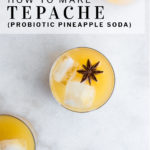
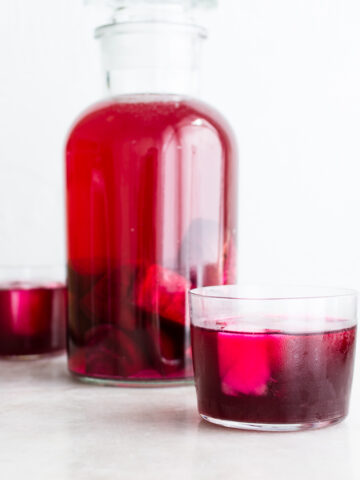
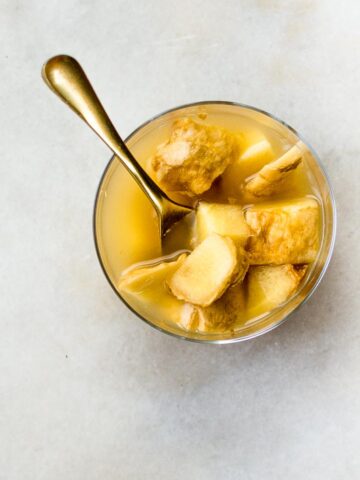
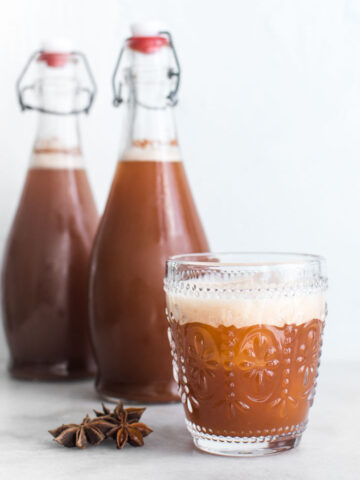
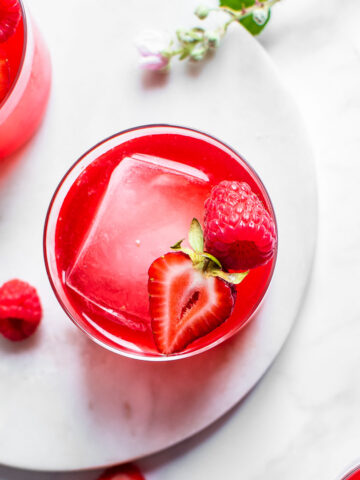
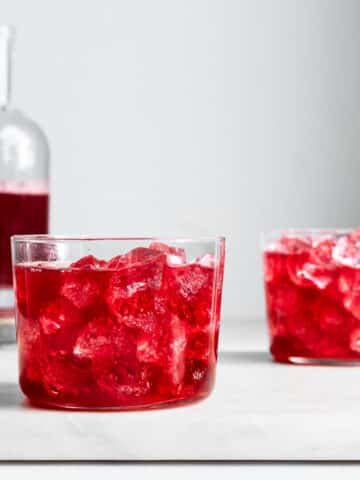
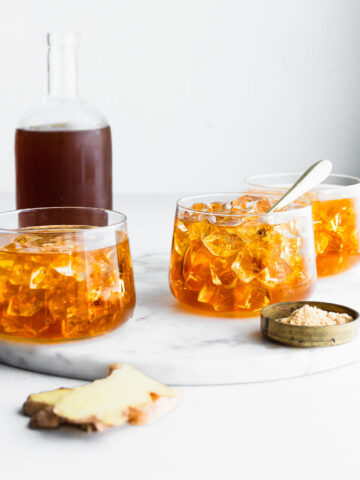
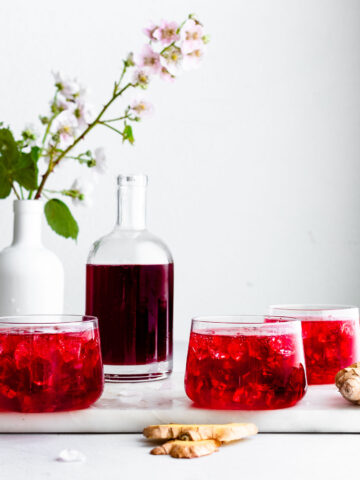
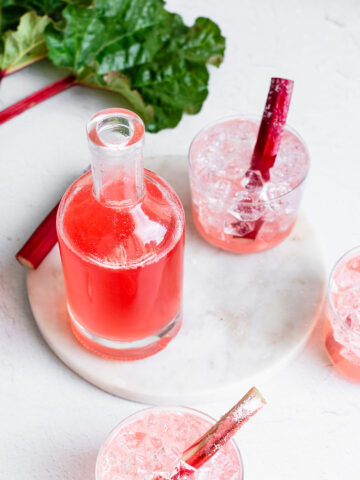
Kenzi Garrod says
How do you make sure the outside is clean enough?
Jenny McGruther says
You don't need to pay any special attention to the outside. A good rinse is fine. The outside contains beneficial yeast that will help colonize the brew.
Marcy says
I don't have access to organic pineapple where I live. I buy non organic pineapple and wash it thoroughly and then leave it on the counter to collect wild yeast and bacteria and then follow the recipe as stated. And always with great success. I don't want to give my Tepache up.
Gina Beekman says
Do you think a ginger bug could be used instead of water kefir? 🤔
Jenny McGruther says
Yes, definitely. Or you can go without, too.
KM says
Could one use whey instead of water kefir in this recipe? Thank you - love your site
Tina says
Have you used coconut palm sugar? What do you think?
Love your site, and your passion!
Jenny McGruther says
You could definitely use coconut palm sugar - any caloric sweetener will work.
4waystoyummy says
This sounds so delicious, but I have never seen organic pineapple where I live. Could it be made with other fruit? Kiwi? Mango? Pear? Hopeful I will be able to try it one day!
Jenny McGruther says
You could certainly try. I have had success with this method using fresh fruit, though - raspberries specifically.
Roslyn says
A Question - or two:
To make the tepache alcoholic or into vinegar do you leave the mixture with the pineapple and spices in to ferment further or after the pineapple and spices are removed?
How do you make it into a vinegar as opposed to making it alcoholic? Not that I am opposed to either!
Jenny McGruther says
Hi Roslyn,
You could leave the spices in for a stronger flavor or remove them for a lighter flavor. Vinegar is the final stage of fermentation, so after it becomes alcoholic, if you continue to let the tepache sit, it will turn into a sort of pineapple vinegar.
Ari says
My roommate and I have been making this for a few weeks now and it's become our fav drink. We've added a whole jalapeno pepper sliced in half and it adds a very subtle heat that makes this drink even better.
Kathryn says
I have made this 4 times now! Love it! Haven’t added star Anise because I didn’t have any and it was still very tasty. I added ginger peels once and that was great. It did get moldy once but the pineapple was fairly old and probably started with a tiny bit of mold. Thanks for a new use for pineapple skins! I also use as a quick face peel.
Jeremy says
Possibly a dumb question, but when you say "cover" do you mean close it with a lid or something permeable like cheese cloth? Should air be allowed to get to it or should it be sealed as it ferments?
Kathryn says
I put a coffee filter over it like my kombucha. Not certain that’s right but it worked for me
Maraina says
Hi.i added yeast to mine after 4 days.did i do the wrong thing by adding the yeast to late.Will it still be alright to drim
Jenny says
Hi Maraina,
I recommend following the recipe as it's written - so no added yeast.
Amanda R. says
This was pretty tasty! When I make it again, I will leave out the star anise as we're not a fan of licorice, see what just cinnamon tastes like, or try cloves instead (your directions mention cloves, the ingredients mention star anise, FYI). It was still good with the star anise!
Any tips for keeping the pineapple and spices submerged? I managed to wedge them under the shoulders of the jar but they popped up a couple of times. I made a second ferment without the fruit/spices of about half of it, and that tasted best to both of us.
DiAnn says
I cannot find organic pineapple. Can I ditch the peel and just use the fruit to make tepache?
Jenny says
I would recommend that you not make it at all. The recommendation for organic pineapple isn't just about pesticide residue on the peel; rather, it's also about the devastating environmental and social impact conventional pineapple has on communities and ecology.
Sonuahua Compton says
Interjecting 🙂 ... I made this with a generic mainstream pineapple and gut severe gut cramping... I would not chance it, you might could make a tasty fermented drink with canned organic pineapple and whey, but It will not have the same natural bacterias found on the skins.
Jessica says
NOM! I have never heard of this until today. It sounds amazing! It's nice that it's so easy to make, and takes so little time to ferment. Thank you for sharing your recipe!
Emily M says
Oh this sounds yummy and I love that it uses the pineapple rind, so we can still eat the fruit too! I will definitely be trying this! Thanks for sharing!
Chelsea Duffy says
This sounds so refreshing and delicious! I love that you can make such an nutrient-packed beverage with a part of the fruit that usually gets thrown into the compost! I know my son will love this as he is crazy for pineapple, so as soon as I come across a good one at the market, I will make this. Thanks for sharing!
Vladka says
I am surprised to learn that 2 days is enough for the tepache to ferment. I love pineapple drinks and this one sounds too good to be true. I must try it to see. Thanks
Shannon Graham says
I can legitimately say that I've never heard of this drink until now. Boy, does it sound delicious. It sounds like it would taste like a sweet but, "spicy" holiday drink!
Tessa Zundel says
What is this drink of the gods that I've never heard of?!! I've been meaning to get my water kefir resurrected and in use again and this is the inspiration I've needed. I've been using my raw apple vinegar that I make here at home to make some switchel and fruit sodas for the kids. I like to have a few ferments going at the same time, though, so Ima thinkin it's time to break out the kefir again!
Milica Vladova says
Oh, this sounds amazing! I love natural probiotics and this recipes is a must-try!
Veronica Wolff-Casey says
My pineapple floats in the solution a little, and I noticed a bit of white film growing on some the exposed pineapple 2 days after putting it up to ferment. I am new to ferments so I am not sure of this is normal?
Jenny says
White film usually indicates Kahm yeast, which is normal during fermentation. If it is foamy, it's a sign of active fermentation. I'd strain and bottle. And, like all ferments, keep your solids submerged.
Jen says
You add finished water kefir, yes? Not the grains?
Jenny says
Yes, you add water kefir, not water kefir grains.
Bethany Wiest says
I don't have any water kefir around, but I like the idea of getting a jumpstart on the fermentation. Would it do any good to add a little whey before fermenting?
Jenny says
You could try whey, or kombucha too. It's not necessary, really. Even though I brew water kefir, I still brew tepache as a wild ferment.
bug says
What is the best way to clean a pineapple peel, since they are shipped and handled uncovered? Are there listeria risks we should mitigate?
Jenny says
I don't worry about listeria in my ferments. Generally, it doesn't tolerate a ph lower than 4.5. Given that most fermented drinks are about 3.5 ph or less, it's not concerning to me; however, listeria can harden which means that it may survive in conditions that grow more acidic over time.
A study on sauerkraut that was specifically inoculated with listeria found that after extended fermentation, there were no detectable levels (https://www.ncbi.nlm.nih.gov/pubmed/16013372) and that's likely because of both the acidic conditions and the way that beneficial bacteria will out-compete other bacteria. Now, that's not the same as a short-fermented tepache, but it gives you some idea of what's happening.
Most experts recommend rinsing your fruits and vegetables with water before preparing them. That's probably sufficient.
Or CARMI says
Can i use Coconut sugar for this?
Jenny says
Yes, it should work with coconut sugar.
Sandy says
Could this be made with maple sugar instead of cane sugar?
Jenny says
Maple sugar would probably work well, too.